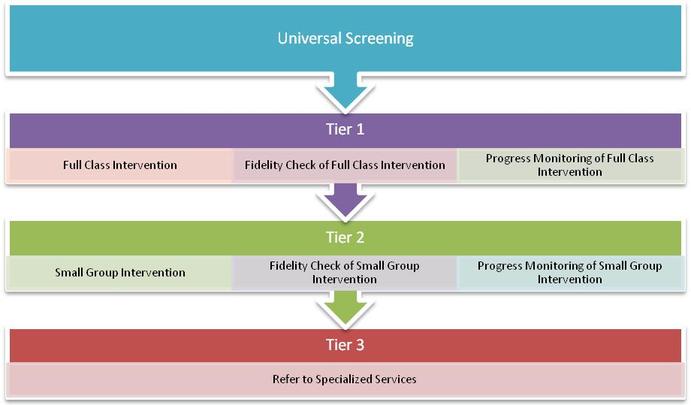Classroom Management & Discipline
Response to Intervention
Response to Intervention (RTI) is a specified process used to intervene with struggling students. It utilizes scientifically-validated interventions to decrease the number of students who do not understand the particular concept being taught. The process follows specified steps to reach students who need a different approach to instruction. The basic steps involved in Response to Intervention work to identify students who are struggling, implement a scientifically-validated research intervention and then check for student progress (Quinn, 2009). These steps are organized into a universal screening and three tiers, as seen below.
Universal Screening
Universal screening is a test or assessment that is used to locate the ability levels of all students in the course. Many times a universal screening is already in place, so this is not an extra task for teachers to squeeze into their busy schedules. Rather, teachers can utilize the universal screening to identify students who are below the targeted skill level (Quinn, 2009).
Tier 1
After the universal screening, teacher's proceed with their daily lesson plans because Tier 1 interventions are delivered to the entire class. Teachers must only check to be sure that they are delivering their full class intervention with scientifically-validated instruction. Having a fidelity check is, however, out of the ordinary in most classrooms. During a fidelity check, a paraprofessional or college comes to make sure that the intervention is being properly delivered. Once it is assured that the intervention is scientifically-validated and being properly delivered, the teacher can begin monitoring the progress of her students. Unfortunately, progress monitoring is not always a routine part of a regular lesson; however, it is through this progress monitoring that teachers can identify which students have increased in skill level, and which have not. While one would hope that all students have increased in skill level, chances are some students will still be behind. It is these students that make up the small group that is taken to Tier 2. As you can see, the amount of students involved in RTI should decrease as the tiers increase (Quinn, 2009).
Tier 2
During Tier 2 teachers should use a different, but still scientifically-validated, intervention with their small group. This intervention can either be in addition to the whole class intervention, or instead of the whole class intervention. In other words, small group interventions can take place with a paraprofessional during the full class intervention, or they can take place in special learning stations before or after the full class intervention. As seen in Tier 1, the teacher (or paraprofessional) should also have a fidelity check with her new intervention. This is often done by the same person who observed the delivery of the first intervention Finally, after the intervention is complete, the teacher should monitor the progress of the students in the small group. The students that have met the target skill level can now join the rest of the class, while any remaining students will be referred to special services, which is part of Tier 3 (Quinn, 2009).
Tier 3
Any students remaining below the target skill level will be referred to special services, such as resource, or any other special education program available at the school (Quinn, 2009). Fortunately, the implementation of RTI greatly decreases the number of students referred to such services. RTI eliminates the assumption that students below a target skill level suffer from a learning disability. Often times, students just need a different intervention in order for them to reach understanding.
An Example Intervention
1
Why RTI?
It should be the goal of every teacher to see every student succeed. Fortunately, every student is different; unfortunately, they do not all learn the same way. Many students who are not at the skill level of their peers are referred to special services, such as resource. However, these students are not always in need of special services, but rather are in need of differentiated instruction. Often times, they need to be taught in a new or different way. Implementing RTI provides an opportunity for these students to increase in skill level by receiving research-supported interventions.
Proverbs 3:13 says, "Blessed is the one who finds wisdom, and the one who gets understanding." As a teacher, I believe it is my responsibility for every student to receive the blessing of understanding in all aspects of learning. Therefore, RTI will be implemented in my classroom.
Proverbs 3:13 says, "Blessed is the one who finds wisdom, and the one who gets understanding." As a teacher, I believe it is my responsibility for every student to receive the blessing of understanding in all aspects of learning. Therefore, RTI will be implemented in my classroom.


